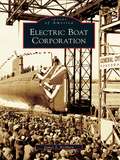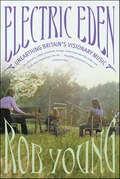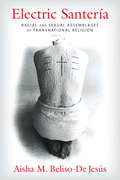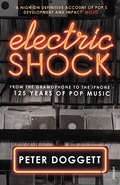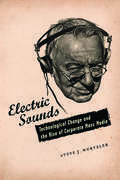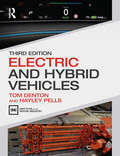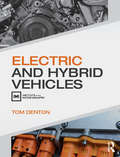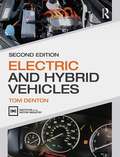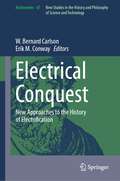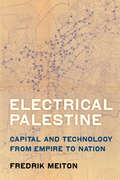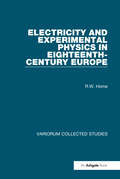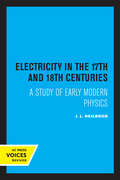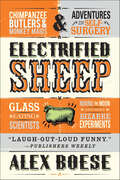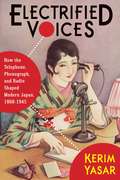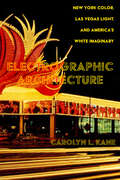- Table View
- List View
Electric Ben: The Amazing Life and Times of Benjamin Franklin
by Robert ByrdElectric Ben is now a 2013 Boston Globe-Horn Book Nonfiction Book Award Winner, a Kirkus Reviews Best Children's Book, a Horn Fanfare Book, and a Robert F. Sibert Honor book!“a true standout…bright, witty, informative and cleverly organized as the man himself.” – The New York TimesA true Renaissance man, Benjamin Franklin was the first American celebrity. In pictures and text, master artist Robert Byrd documents Franklin's numerous and diverse accomplishments, from framing the Constitution to creating bifocals. The witty, wise, and endlessly curious Franklin is the perfect subject for Byrd's lively style and vibrant art. The pages pulse with facts, quotes, and captions, while the inventive design and intricately detailed illustrations make a striking tribute to the brilliant American.
Electric Boat Corporation
by James S. ReyburnElectric Boat Corporation has been a world leader in submarine development, design, and construction for more than a century. In 1900, the company delivered the Holland, the first submarine accepted by the United States Navy. Fifty-five years later, it turned fantasy into fact by sending the world's first nuclear-powered ship, the submarine Nautilus, off on its maiden voyage. It later built the world's first ballisticmissile-firing submarine, the George Washington, and most of the nation's current underseas fleet. Between those years, it pioneered standardized construction of merchant ships, submarine chasers, torpedo boats, and yachts and also produced airplanes, fishing trawlers, diesel engines, and electric motors. This collection of more than 200 archival photographs traces the company's sometimes roller-coaster existence through 10 historic decades when America--and Electric Boat Corporation--grew into an industrial giant. It is an engaging collective portrait of American ingenuity, know-how, and persistence driving technology to new heights.
Electric Dreamland: Amusement Parks, Movies, and American Modernity (Film and Culture Series)
by Lauren RabinovitzAmusement parks were the playgrounds of the working class in the early twentieth century, combining numerous, mechanically-based spectacles into one unique, modern cultural phenomenon. Lauren Rabinovitz describes the urban modernity engendered by these parks and their media, encouraging ordinary individuals to sense, interpret, and embody a burgeoning national identity. As industrialization, urbanization, and immigration upended society, amusement parks tempered the shocks of racial, ethnic, and cultural conflict while shrinking the distinctions between gender and class. Following the rise of American parks from 1896 to 1918, Rabinovitz seizes on a simultaneous increase in cinema and spectacle audiences and connects both to the success of leisure activities in stabilizing society. Critics of the time often condemned parks and movies for inciting moral decline, yet in fact they fostered women's independence, racial uplift, and assimilation. The rhythmic, mechanical movements of spectacle also conditioned audiences to process multiple stimuli. Featuring illustrations from private collections and accounts from unaccessed archives, Electric Dreamland joins film and historical analyses in a rare portrait of mass entertainment and the modern eye.
Electric Eden: Unearthing Britain's Visionary Music
by Rob YoungA Kirkus Reviews Best Nonfiction of 2011 title In the late 1960s, with popular culture hurtling forward on the sounds of rock music, some brave musicians looked back instead, trying to recover the lost treasures of English roots music and update them for the new age. The records of Fairport Convention, Pentangle, Steeleye Span, and Nick Drake are known as "folk rock" today, but Rob Young's epic, electrifying book makes clear that those musicians led a decades-long quest to recover English music-and with it, the ancient ardor for mysticism and paganism, for craftsmanship and communal living.It is a commonplace that rock and R&B came out of the folk and blues revivals of the early 1960s, and Young shows, through enchanting storytelling and brilliant commentary, that a similar revival in England inspired the Beatles and Pink Floyd, Led Zeppelin and Traffic, Kate Bush and Talk Talk. Folklorists notated old songs and dances. Marxists put folk music forward as the true voice of the people. Composers like Benjamin Britten and Ralph Vaughan Williams devised rich neo-traditional pageantry. Today, the pioneers of the "acid folk" movement see this music as a model for their own.Electric Eden is that rare book which has something truly new to say about popular music, and like Greil Marcus's LipstickTraces, it uses music to connect the dots in a thrilling story of art and society, of tradition and wild, idiosyncratic creativity.
Electric Indiana: The Rise and Fall of the World's Greatest Interurban Railway Center, 1893–1941 (Railroads Past and Present)
by Carlos Arnaldo SchwantesIn the early twentieth century, an epic battle was waged across America between the interurban railway and the automobile, two technologies that arose at roughly the same time in the late 1890s. Nowhere was this conflict more evident than in the Midwest, and specifically Indiana, where cities of industry such as Indianapolis, Gary, and Terre Haute were growing faster every day. By 1904, Indianapolis had opened the Traction Terminal, which was widely acclaimed to be the largest and most impressive interurban station in the world. Yet, today there is only 90-mile remnant of this one great system still operating within Indiana.Featuring over 90 illustrations and featuring contemporary accounts and newspaper articles from the period, Electric Indiana is a biographical study of the rise and fall of a onetime important transportation technology that achieved its most impressive development within the Hoosier state.
Electric Interurbans and the American People (Railroads Past and Present)
by H. Roger Grant“A well-written social history of the shortest-lived major US transportation mode” from the railway historian and author of A Mighty Fine Road (Choice).One of the most intriguing yet neglected pieces of American transportation history, electric interurban railroads were designed to assist shoppers, salesmen, farmers, commuters, and pleasure-seekers alike with short distance travel. At a time when most roads were unpaved and horse and buggy travel were costly and difficult, these streetcar-like electric cars were essential to economic growth. But why did interurban fever strike so suddenly and extensively in the Midwest and other areas? Why did thousands of people withdraw their savings to get onto what they believed to be a “gravy train?” How did officials of competing steam railroads respond to these challenges to their operations? H. Roger Grant explores the rise and fall of this fleeting form of transportation that started in the early 1900s and was defunct just 30 years later. Perfect for railfans, Electric Interurbans and the American People is a comprehensive contribution for those who love the flanged wheel.“With this book, the subject no longer has footnote status. In fact, Grant’s work deserves a place alongside some of the other landmark surveys of the subject . . . Here, Grant moves beyond the receiverships, the rickety track, and all that fascinating rolling stock. He shows us why the whole darned thing mattered.” —Railroad History“H. Roger Grant has produced a fine social history of America’s electric interurbans, exploring the relationship between people and those railway enterprises. The book fills a void, is eminently readable, and richly illustrated.” —Don L. Hofsommer, author of Off the Main Lines
Electric October: Seven World Series Games, Six Lives, Five Minutes of Fame That Lasted Forever
by Kevin CookAn “entertaining, well-researched” account of the first World Series to be televised—and the forgotten stories of six Yankees and Dodgers (Publishers Weekly, starred review).The 1947 World Series was “the most exciting ever” in the words of Joe DiMaggio, with a decade’s worth of drama packed into seven games between the mighty New York Yankees and underdog Brooklyn Dodgers. It was Jackie Robinson’s first Series, a postwar spectacle featuring Frank Sinatra, Ernest Hemingway and President Harry Truman in supporting roles. It was also the first televised World Series—sportswriters called it “Electric October.”But for all the star power on display, the outcome hinged on role players: Bill Bevens, a journeyman who knocked on the door of pitching immortality; Al Gionfriddo and Cookie Lavagetto, bench players at the center of the Series’ iconic moments; Snuffy Stirnweiss, a wartime batting champion who never got any respect; and managers Bucky Harris and Burt Shotton, each an unlikely choice to run his team. Six men found themselves plucked from obscurity to shine on the sport’s greatest stage. But their fame was fleeting; three would never play another big-league game, and all six would be forgotten.Kevin Cook brings the ‘47 Series back to life, introducing us to men whose past offered no hint they were destined for extraordinary things. For some, the Series was a memory to hold on to. For others, it would haunt them to the end of their days. And for us, Cook offers new insights—some heartbreaking, some uplifting—into what fame and glory truly mean.“A wonderful book.” —Ken Burns“Impressively reported, smoothly written.” —Kirkus Reviews“Mr. Cook evokes earlier books by Roger Kahn, Peter Golenbock and David Halberstam in a poignant study that goes beyond baseball and its immortals, like Jackie Robinson and Joe DiMaggio . . . His thoroughly researched narrative probes their personalities [and] relives the gladiatorial 1947 rivalry between the two hometown teams, game by game.” —The New York TimesIncludes photographs
Electric Pictures: A Guide to the Films, Film-Makers & Cinemas of Worthing & Shoreham
by James Clarke Ellen Cheshire David LelandWritten as part of the Worthing WOW festival celebrations, Electric Pictures commemorates 120 years of film in the Sussex coastal towns of Worthing and Shoreham, capturing the region’s rich cinematic legacy and its place in British film history. From film-making pioneers through to blockbuster films and key events in the film history of the coast, this volume draws on research from film archives and local history resources to tell the story of the south coast film world. Richly illustrated and featuring contributions from local historians and film and theatre specialists, this book also includes an additional Heritage Trail guide that reveals key filming locations and the towns’ cinemas.
Electric Santería: Racial and Sexual Assemblages of Transnational Religion (Gender, Theory, and Religion)
by Aisha Beliso-De JesúsSantería is an African-inspired, Cuban diaspora religion long stigmatized as witchcraft and often dismissed as superstition, yet its spirit- and possession-based practices are rapidly winning adherents across the world. Aisha M. Beliso-De Jesús introduces the term "copresence" to capture the current transnational experience of Santería, in which racialized and gendered spirits, deities, priests, and religious travelers remake local, national, and political boundaries and reconfigure notions of technology and transnationalism.Drawing on eight years of ethnographic research in Havana and Matanzas, Cuba, and in New York City, Miami, Los Angeles, and the San Francisco Bay area, Beliso-De Jesús traces the phenomenon of copresence in the lives of Santería practitioners, mapping its emergence in transnational places and historical moments and its ritual negotiation of race, imperialism, gender, sexuality, and religious travel. Santería's spirits, deities, and practitioners allow digital technologies to be used in new ways, inciting unique encounters through video and other media. Doing away with traditional perceptions of Santería as a static, localized practice or as part of a mythologized "past," this book emphasizes the religion's dynamic circulations and calls for nontranscendental understandings of religious transnationalisms.
Electric Shock: From the Gramophone to the iPhone – 125 Years of Pop Music
by Peter DoggettAmbitious and groundbreaking, Electric Shock tells the story of popular music, from the birth of recording in the 1890s to the digital age, from the first pop superstars of the twentieth century to the omnipresence of music in our lives, in hit singles, ringtones and on Spotify. Over that time, popular music has transformed the world in which we live. Its rhythms have influenced how we walk down the street, how we face ourselves in the mirror, and how we handle the outside world in our daily conversations and encounters. It has influenced our morals and social mores; it has transformed our attitudes towards race and gender, religion and politics. From the beginning of recording, when a musical performance could be preserved for the first time, to the digital age, when all of recorded music is only a mouse-click away; from the straitlaced ballads of the Victorian era and the ‘coon songs’ that shocked America in the early twentieth century to gangsta rap, death metal and the multiple strands of modern dance music: Peter Doggett takes us on a rollercoaster ride through the history of music. Within a narrative full of anecdotes and characters, Electric Shock mixes musical critique with wider social and cultural history and shows how revolutionary changes in technology have turned popular music into the lifeblood of the modern world.
Electric Sounds: Technological Change and the Rise of Corporate Mass Media
by Stephen WurtzlerA history of sound recording and reproduction and how this technology transformed American mass media.
Electric Sounds: Technological Change and the Rise of Corporate Mass Media (Film and Culture Series)
by Steve WurtzlerElectric Sounds brings to vivid life an era when innovations in the production, recording, and transmission of sound revolutionized a number of different media, especially the radio, the phonograph, and the cinema. The 1920s and 1930s marked some of the most important developments in the history of the American mass media: the film industry's conversion to synchronous sound, the rise of radio networks and advertising-supported broadcasting, the establishment of a federal regulatory framework on which U.S. communications policy continues to be based, the development of several powerful media conglomerates, and the birth of a new acoustic commodity in which a single story, song, or other product was made available to consumers in multiple media forms and formats.But what role would this new media play in society? Celebrants saw an opportunity for educational and cultural uplift; critics feared the degradation of the standards of public taste. Some believed acoustic media would fulfill the promise of participatory democracy by better informing the public, while others saw an opportunity for manipulation. The innovations of this period prompted not only a restructuring and consolidation of corporate mass media interests and a shift in the conventions and patterns of media consumption but also a renegotiation of the social functions assigned to mass media forms. Steve J. Wurtzler's impeccably researched history adds a new dimension to the study of sound media, proving that the ultimate form technology takes is never predetermined. Rather, it is shaped by conflicting visions of technological possibility in economic, cultural, and political realms. Electric Sounds also illustrates the process through which technologies become media and the ways in which media are integrated into American life.
Electric Trolleys of Washtenaw County (Images of Rail)
by H. Mark Hildebrandt Martha A. ChurchillElectric streetcars and interurbans appeared in Washtenaw County in the 1890s. Evolved from horse-drawn streetcars, electric cars were ideal for public transportation. They were cheap, fast, and went to plenty of places. The system developed around Ann Arbor and Ypsilanti, branching out to Detroit to the east and Jackson to the west. Bigger and better equipment was added, and larger companies took over the small ones. In western Washtenaw County, two interurban railways engaged in a struggle for survival. Occasionally the interurbans crashed into buildings or one another, with disastrous results. Electric Trolleys of Washtenaw County explains how electric mass transportation flourished starting in the 1890s, why it bloomed, and why it suddenly became extinct after only a few decades.
Electric and Hybrid Vehicles
by Tom Denton Hayley PellsElectric and hybrid vehicles are now the present, not the future. This straightforward and highly illustrated full-colour textbook is endorsed by the Institute of the Motor Industry (IMI) and introduces the subject for further education and undergraduate students as well as technicians and workshop owners, with sections for drivers who are interested to know more. This new edition contains extensively updated content, especially on batteries, charging and the high-voltage pathway and includes all new case studies and new images, photos and flow charts throughout. It covers the different types of electric vehicle, costs and emissions and the charging infrastructure before moving on to explain how hybrid and electric vehicles work. A chapter on electrical technology introduces learners to subjects such as batteries, control systems and charging, which are then covered in more detail within their own chapters. The book also covers the maintenance and repair procedures of these vehicles, including diagnostics, servicing, repair and first-responder information. The book is particularly suitable for students studying towards IMI Level 1 Award in Hybrid Electric Vehicle Awareness, IMI Level 2 Award in Hybrid Electric Vehicle Operation and Maintenance, IMI Level 3 Award in Hybrid Electric Vehicle Repair and Replacement, IMI Level 4 Award in the Diagnosis, Testing and Repair of Electric/Hybrid Vehicles and Components, IMI accreditation, City & Guilds (C&G) and all other EV/hybrid courses.
Electric and Hybrid Vehicles
by Tom DentonThe first book on electric and hybrid vehicles (EVs) written specifically for automotive students and vehicle owners Clear diagrams, photos and flow charts outline the charging infrastructure, how EV technology works, and how to repair and maintain hybrid and electric vehicles Optional IMI online eLearning materials enable students to study the subject further and test their knowledge Full coverage of IMI Level 2 Award in Hybrid Electric Vehicle Operation and Maintenance, IMI Level 3 Award in Hybrid Electric Vehicle Repair and Replacement, IMI Accreditation, C&G and other EV/Hybrid courses. The first book on electric and hybrid vehicles (endorsed by the IMI) starts with an introduction to the market, covering the different types of electric vehicle, costs and emissions, and the charging infrastructure, before moving on to explain how hybrid and electric vehicles work. A chapter on electrical technology introduces learners to subjects such as batteries, control systems and charging which are then covered in more detail within their own chapters. The book also covers the maintenance and repair procedures of these vehicles, including fault finding, servicing, repair and first-responder information. Case studies are used throughout to illustrate different technologies.
Electric and Hybrid Vehicles
by Tom DentonElectric and hybrid vehicles are now the present, not the future. This straightforward and highly illustrated full colour textbook is endorsed by the Institute of the Motor Industry, and introduces the subject for further education and undergraduate students as well as technicians. This new edition includes a new section on diagnostics and completely updated case studies. It covers the different types of electric vehicle, costs and emissions, and the charging infrastructure, before moving on to explain how hybrid and electric vehicles work. A chapter on electrical technology introduces learners to subjects such as batteries, control systems and charging which are then covered in more detail within their own chapters. The book also covers the maintenance and repair procedures of these vehicles, including fault finding, servicing, repair and first-responder information. Clear diagrams, photos and flow charts outline the charging infrastructure, how EV technology works, and how to repair and maintain hybrid and electric vehicles. Optional IMI online eLearning materials enable students to study the subject further and test their knowledge. It is particularly suitable for students studying towards IMI Level 2 Award in Hybrid Electric Vehicle Operation and Maintenance, IMI Level 3 Award in Hybrid Electric Vehicle Repair and Replacement, IMI Accreditation, C&G and other EV/Hybrid courses.
Electrical Conquest: New Approaches to the History of Electrification (Archimedes #67)
by W. Bernard Carlson Erik M. ConwayThis book, drawing on fresh scholarship, investigates electrification in new places and across different time periods. While much of our understanding of electrification as a historical process is based on the seminal work done by Thomas P. Hughes in Networks of Power (1983), the scholars in this volume expand and revise Hughes’ systems approach to suggest that electrification is a heterogeneous and contingent process. Moreover, the contributors suggest that the conquest of the world by electricity remains incomplete despite more than a century elapsing. Above all, though, this book provides context for thinking about what lies ahead as humans continue their conquest of the earth through electricity. As we become increasingly dependent on electricity to power our lights, heat and cool our homes, turn the wheels of industry, and keep our information systems humming, so we are ever more vulnerable when the grid runs into trouble.Chapter "Surveying the Landscape: The Oil Industry and Alternative Energy in the 1970s" is available open access under a Creative Commons Attribution 4.0 International License via link.springer.com.
Electrical Palestine: Capital and Technology from Empire to Nation
by Fredrik MeitonElectricity is an integral part of everyday life—so integral that we rarely think of it as political. In Electrical Palestine, Fredrik Meiton illustrates how political power, just like electrical power, moves through physical materials whose properties govern its flow. At the dawn of the Arab-Israeli conflict, both kinds of power were circulated through the electric grid that was built by the Zionist engineer Pinhas Rutenberg in the period of British rule from 1917 to 1948. Drawing on new sources in Arabic, Hebrew, and several European languages, Electrical Palestine charts a story of rapid and uneven development that was greatly influenced by the electric grid and set the stage for the conflict between Arabs and Jews. Electrification, Meiton shows, was a critical element of Zionist state building. The outcome in 1948, therefore, of Jewish statehood and Palestinian statelessness was the result of a logic that was profoundly conditioned by the power system, a logic that has continued to shape the area until today.
Electricity and Experimental Physics in Eighteenth-Century Europe (Variorum Collected Studies)
by R.W. HomeAt the beginning of the 18th century there was no science of physics as we recognise it today; by the early years of the nineteenth century, there was. The articles in this volume are concerned with the process by which this came about. They focus, in particular, on the rise of experimental physics and the interactions between experiment, theory and mathematics in the study of electricity and, to a lesser extent, magnetism and physical optics during this period. Along the way, they provide a significant reassessment of Isaac Newton’s influence on the science of his successors. A further recurring theme is the process by which ideas were disseminated within the expanding scientific community of the day, and the manner of their reception, often in a form somewhat different from that envisaged by their first inventors, as Professor Home argues took place in the case of Franklin. The social and intellectual context of the ’scientist’, indeed, is the specific subject of several essays, dealing not only with England and France, but also offering new insights into the position of science in 18th-century Russia. Au début du 18e s., la science physique telle que nous l’entendons de nos jours, n’existait pas; dès les premières années du 19e s., cela n’était plus le cas. Les articles contenus dans ce volume s’intéressent au procédé qui a provoqué ce changement. Ils s’attachent plus particulièrement à la montée de la physique expérimentale et à l’interaction entre expérience, théorie et mathématiques en ce qui concerne l’étude de l’électricité et, dans une moindre mesure, celle du magnétisme et de l’optique physique durant cette période. Ce faisant, les études fournissent une ré-évaluation significative de l’influence d’Isaac Newton sur la science de ses successeurs. Un autre thème est celui du processus par lequel les idées étaient disséminées à l’époque au sein d’une communauté scientifique en pleine expans
Electricity in the 17th and 18th Centuries: A Study of Early Modern Physics
by J. L. HeilbronThis title is part of UC Press's Voices Revived program, which commemorates University of California Press’s mission to seek out and cultivate the brightest minds and give them voice, reach, and impact. Drawing on a backlist dating to 1893, Voices Revived makes high-quality, peer-reviewed scholarship accessible once again using print-on-demand technology. This title was originally published in 1979.
Electrified Sheep: Glass-eating Scientists, Nuking The Moon, And More Bizarre Experiments
by Alex Boese"Perfect summertime reading—preferably with a friend nearby who can be constantly interrupted with unsettling facts." —Daily Mail (UK )Benjamin Franklin was a pioneering scientist, leader of the Enlightenment, and a founding father of the United States. But perhaps less well known is that he was also the first person to use mouth-to-mouth resuscitation on an electric-shock victim. Odder still, it was actually mouth-to-beak resuscitation on a hen that he himself had shocked. Welcome to some of the weirdest and most wonderful experiments ever conducted in the name of science. Filled with stories of science gone strange, Electrified Sheep is packed with eccentric characters, irrational obsessions, and extreme experiments. Watch as scientists attempt to nuke the moon, wince at the doctor who performs a self-appendectomy, and catch the faint whiff of singed wool from an electrified sheep.
Electrified Voices: How the Telephone, Phonograph, and Radio Shaped Modern Japan, 1868–1945 (Studies of the Weatherhead East Asian Institute, Columbia University)
by Kerim YasarLong before karaoke’s ubiquity and the rise of global brands such as Sony, Japan was a place where new audio technologies found eager users and contributed to new cultural forms. In Electrified Voices, Kerim Yasar traces the origins of the modern soundscape, showing how the revolutionary nature of sound technology and the rise of a new auditory culture played an essential role in the formation of Japanese modernity.A far-reaching cultural history of the telegraph, telephone, phonograph, radio, and early sound film in Japan, Electrified Voices shows how these technologies reshaped the production of culture. Audio technologies upended the status of the written word as the only source of prestige while revivifying traditional forms of orality. The ability to reproduce and transmit sound, freeing it from the constraints of time and space, had profound consequences on late nineteenth-century language reform; twentieth-century literary, musical, and cinematic practices; the rise of militarism and nationalism in the 1920s and 30s; and the transition to the postwar period inaugurated by Emperor Hirohito’s declaration of unconditional surrender to Allied forces—a declaration that was recorded on a gramophone record and broadcast throughout the defeated Japanese empire. The first cultural history in English of auditory technologies in modern Japan, Electrified Voices enriches our understanding of Japanese modernity and offers a major contribution to sound studies and global media history.
Electro Swing: Resurrection, Recontextualisation, and Remix (Ashgate Popular and Folk Music Series)
by Chris InglisElectro swing is a relatively recent musical style and scene which combines the music of the swing era with that of the age of electronic dance music. Chris Inglis considers key questions about electro swing’s place in contemporary society, including what it may mean for a contemporary genre to be so reliant upon the influences of the past; the different ways in which jazz may be presented to a modern audience; how one may go about defining jazz in todays postmodern world; and how this emergent genre may be analysed in terms of the wider issues of race and class consumption.
Electroconvulsive Therapy in America: The Anatomy of a Medical Controversy (Routledge Studies in Cultural History #49)
by Jonathan SadowskyElectroconvulsive Therapy is widely demonized or idealized. Some detractors consider its very use to be a human rights violation, while some promoters depict it as a miracle, the "penicillin of psychiatry." This book traces the American history of one of the most controversial procedures in medicine, and seeks to provide an explanation of why ECT has been so controversial, juxtaposing evidence from clinical science, personal memoir, and popular culture. Contextualizing the controversies about ECT, instead of simply engaging in them, makes the history of ECT more richly revealing of wider changes in culture and medicine. It shows that the application of electricity to the brain to treat illness is not only a physiological event, but also one embedded in culturally patterned beliefs about the human body, the meaning of sickness, and medical authority.
Electrographic Architecture: New York Color, Las Vegas Light, and America's White Imaginary
by Prof. Carolyn L. KaneBridging histories of technology, media studies, and aesthetics, Electrographic Architecture forges a critical narrative of the ways in which illuminated light and color have played key roles in the formation of America's white imaginary. Carolyn L. Kane charts the rise of the country's urban advertisements, light empires, and neoclassical buildings in the early twentieth century; the midcentury construction of polychromatic electrographic spectacles; and their eclipse by informatically intense, invisible algorithms at the dawn of the new millennium. Drawing on archival research, interviews, and visual analysis, Electrographic Architecture shows how the development of America's electrographic surround runs parallel to a new paradigm of power, property, and possession.

